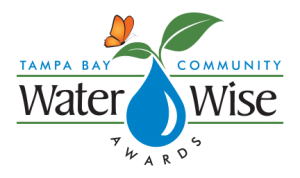What image comes to mind when you hear the term “drought-tolerant plant?”

Ugh. Unfortunately, there are a handful of common misconceptions about drought-tolerant landscaping that just won’t go away.
Too often, the phrase “drought-tolerant” immediately conjures up images of landscapes appropriate for the desert southwest – full of cacti & succulents. But here in central FL, our landscape plants often need to be ready to tolerate BOTH extremes – dry OR wet. Plus high humidity and the occasional winter frost… and maybe some salt spray, and… well, you get the idea…
This is no desert.
April is actually one of Florida’s driest months – hence being designated Florida’s “Water Conservation Month.” For that reason, today’s post attempts to shatter some stubborn stereotypes about “drought tolerant” landscaping in Florida. Let’s dive into the diversity in shape, color, size, and form that drought-tolerant plants can bring to your central FL landscape!
(IMPORTANT NOTE: If your soil typically tends to constantly stay soggy, this post isn’t for you…)
Simpson’s Stopper –

This exceptional native FL plant can be grown as a shrub, hedge, or small tree. They have springtime blooms (a true pollinator paradise), red berries (food for birds), fragrant leaves (smells like allspice when rubbed or crushed), and are drought tolerant (once established).

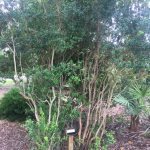
With such great versatility, it’s no wonder this FL native has become so popular in landscapes in recent years.
For more info about Simpson’s stopper, check out: http://gardeningsolutions.ifas.ufl.edu/plants/trees-and-shrubs/shrubs/simpsons-stopper.html
Weeping Yaupon Holly –
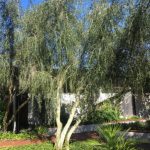
Evergreen foliage, bright red berries, plus a weeping growth form straight out of a Dr. Seuss book… and it’s a FL native too!
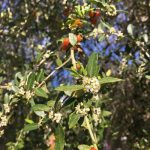
There’s plenty to love about this medium-sized drought tolerant tree.
(Note: There are non-weeping and “dwarf” forms of Yaupon holly too.)
For more info: http://gardeningsolutions.ifas.ufl.edu/plants/trees-and-shrubs/shrubs/weeping-yaupon-holly.html
https://www.fnps.org/plants/plant/ilex-vomitoria
Walter’s Viburnum –

The dense, deep green foliage is attractive and provides good habitat value. Flowers and fruits support pollinators and other wildlife. And for those gardeners who want to include more native plants in their landscapes, Walter’s viburnum is another great FL native that is increasingly popular in the landscape industry!
NOTE: There are many cultivars of Walter’s viburnum available, and they can vary A LOT in growth form and size – from “dwarf” shrubs to small trees – so choose wisely to achieve your Florida-Friendly Landscaping goal of “right plant, right place.”
For more info: http://gardeningsolutions.ifas.ufl.edu/plants/trees-and-shrubs/shrubs/walters-viburnum.html
Rusty Lyonia –

While not as easy to find as Simpson’s stopper or Walter’s viburnum, Rusty Lyonia is a tough, versatile native scrub plant that has loads of un-tapped landscape potential. New growth is covered in rust-colored fuzz, (from which Rusty Lyonia derives its name).

As it grows, the dense foliage changes to light green, then deep green. Older leaves have in-rolled margins, and often look like they’ve been dusted in sugar.
Abundant clusters of bell-shaped flowers appear mid-winter, providing a welcome food source for pollinators.
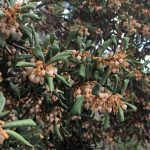
With multi-toned foliage, mid-winter flowers, and a unique growth habit that can almost be described as bonsai-like, this is a plant with a lot of character.
Interesting trivia fact – The unique, twisted trunks and branches of Rusty Lyonia have actually been used as a source of “crooked wood” for the artificial plant industry!

Note: Rusty lyonia is currently only grown commercially by a handful of nurseries in the entire state, so you’ll need to check with native plant nurseries or local native plant sales.
http://www.sfrc.ufl.edu/Extension/4h/ecosystems/_plants/Rusty_lyonia/index.html
Marlberry (Ardisia escallonioides) –

This under-appreciated native plant has large, glossy leaves. It tolerates alkaline soils/sands. Clusters of flowers grow at branch tips, turning into dark berries that provide food for birds.
Unfortunately, Marlberry’s evil invasive cousin Coral Ardisia gets all the attention, but Marlberry certainly deserves to be more widely known. Aside from a handful of nurseries that specialize in native plants, Marlberry isn’t currently widely available. However, increasing interest in FL native plants is helping to create more demand.
Trivia fact: Marlberry’s name is derived from “Marble-berry” which described the small round fruits of this shrub.
More info: https://flawildflowers.org/flower-friday-ardisia-escallonioides/
Beautyberry (Callicarpa americana)
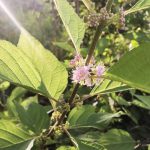
Tiny, delicate pink flowers clustered around the branch are followed by bright magenta berry clusters in the fall. If you want to keep your beautyberry’s growth more compact, give it a hard pruning in early spring, along with an occasional shaping up through the growing season. That will help keep beautyberry’s natural “legginess” in check.
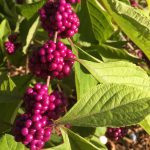
Note: Beautyberry often drops its leaves for winter, while retaining berries – causing some bushes to briefly resemble neon berry shish kebabs, so plan its placement in your landscape accordingly. http://gardeningsolutions.ifas.ufl.edu/plants/trees-and-shrubs/shrubs/beautyberry.html
Muhly Grass –

The brightly-colored flower stalks of Muhly grass are an eye-catching fall favorite, providing wonderful color, texture, and motion into the landscape. But native Muhly grass looks good in the landscape nearly year-round. It can handle wet or dry conditions, and can add elements of movement and sound to a landscape when planted en masse.
TIP: If your Muhly grass needs tidying-up or dividing, late winter or early spring is the right time, just before the flush of new growth. Pruning Muhly grass later in the year will spoil the spectacular fall show.
For more information about Muhly grass care, visit: http://gardeningsolutions.ifas.ufl.edu/plants/ornamentals/muhly-grass.html
If pink isn’t your color, there’s a white variety of Muhly grass too,… although it will probably require some extra searching to find a nursery that carries it.
Elliott’s Lovegrass –
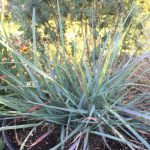
Or… if you want something really different (and slightly smaller), check out the interesting blue-hued Elliott’s Lovegrass! (Lovegrass is not widely available with the exception of a few native nurseries and local plant sales, so it would likely require some extra effort to seek out.)
https://www.regionalconservation.org/beta/nfyn/plantdetail.asp?tx=Eragelli
https://flawildflowers.org/flower-friday-eragrostis-elliottii/
Coontie –

Florida’s only native cycad, the coontie is increasingly common due to its interesting appearance, low-maintenance, and drought tolerance. TIP: Because their tap-root is difficult to transplant when fully-grown, coonties are typically sold while still young. Full-grown coonties can be about 5′ across, so be sure to leave enough room when choosing the planting location.
For more info: http://gardeningsolutions.ifas.ufl.edu/plants/trees-and-shrubs/palms-and-cycads/coontie.html
https://fnps.org/plants/plant/zamia-integrifolia
Coral Bean (Erythrina herbacea) –

Drought and salt tolerant. The red tube-shaped flowers of Coral Bean appear just at the right point to provide food for hummingbirds during their spring migrations. (Note: Use with caution around pets and children – Seeds of coral bean are toxic.)
For more information: http://gardeningsolutions.ifas.ufl.edu/plants/ornamentals/coral-bean.html
Saw palmetto – (Serenoa repens) –

This native palm is highly drought tolerant. It features a low, clumping growth form. Depending on variety, leaves can be either green or silvery-blue. Flowers and fruit provide excellent wildlife value for birds and pollinators. Similar to coontie, be sure to leave sufficient room when planting.
More info: https://fnps.org/plants/plant/serenoa-repens
http://gardeningsolutions.ifas.ufl.edu/plants/trees-and-shrubs/palms-and-cycads/saw-palmetto.html
Narrowleaf silkgrass (Pityopsis graminifolia) –
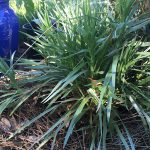
With silvery-blue grass-like foliage, yellow fall blooms, and great drought tolerance, narrow-leaf silkgrass can be a great feature in drought-tolerant landscapes.

Narrowleaf silkgrass goes by a number of descriptive names – Silkyleaf aster, grassleaved goldenaster, etc. For more info: https://www.fnps.org/plants/plant/pityopsis-graminifolia
http://hawthornhillwildflowers.blogspot.com/2009/11/grassleaved-goldenaster-pityopsis.html
Texas sage (Leucophyllum frutescens)–

There are a handful of plants that excel under the most difficult landscape conditions – Texas sage is a great example. While many landscape plants struggle to grow in well-drained, nutrient-poor, alkaline soils under full sun, it is under those precise conditions that Texas sage thrives. In fact, the two things Texas sage WON’T tolerate are soggy, fertilized soil and shade. With enough cold tolerance to handle Zone 9’s winter chills too, Texas sage certainly deserves inclusion in the Florida-Friendly Landscaping toolkit, since this plant can handle some really difficult conditions, and it looks good while doing it.
Bonus: Don’t like to prune often? Texas sage is a slow grower. Occasional trims are all that’s needed to maintain the natural growth form and prevent any leggy branching.
Loquat –
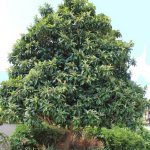
Not many fruit trees are able to thrive in poor, sandy soils. But loquats grow so well in the dry, western parts of Pasco that New Port Richey is home to an annual springtime Loquat Festival!
For more info, check out: http://gardeningsolutions.ifas.ufl.edu/plants/trees-and-shrubs/trees/loquat.html
Pineapple Guava / Feijoa – (Acca sellowiana) –
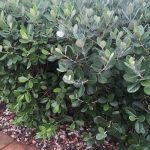
Pineapple Guava / Feijoa – (Acca sellowiana) Drought and salt tolerant, the Pineapple guava, or feijoa can be trained as a shrub or a small tree. For more info, check out: http://gardeningsolutions.ifas.ufl.edu/plants/trees-and-shrubs/shrubs/pineapple-guava.html
Bougainvillea –
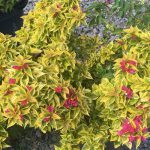
These plants thrive on neglect, heat, and full sun. They bloom profusely during the peak of the springtime dry season. While older, traditional varieties have a reputation for being thorny and difficult to control, some newer varieties have more compact growth habits and greatly reduced thorns (ex: Bougainvillea “Pink Pixie”).
For more info: http://gardeningsolutions.ifas.ufl.edu/plants/ornamentals/bougainvillea.html
Florida privet – (Forestiera segregata) –
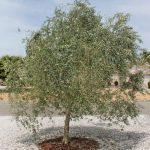
Florida privet – (Forestiera segregata) – Featuring small shiny leaves, black springtime berries that provide food for birds, and an ability to handle full sun and well-drained soils, this FL native is vastly under-appreciated.
Note: Typically deciduous in central FL, so plan placement in the landscape accordingly. For more info
Liatris / Blazing stars –

Tall, slender purple spikes of flowers bloom in fall. (Growing conditions vary depending on species, but some are exceptionally drought tolerant.) http://nwdistrict.ifas.ufl.edu/hort/2016/09/22/florida-wildflowers-blazing-star/
IMPORTANT NOTE!!!
Even the most drought-tolerant plants will need some supplemental watering to get established in a landscape. In fact, sometimes they can be extra-thirsty until their massive root system can spread out into the soil. Be sure to provide supplemental watering to ensure a strong start.
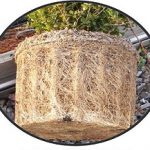
(If the root system has become pot-bound prior to planting, it’s important to shave off the outside of the root-ball to allow new roots to emerge. For more information on this process, see “Planting trees from containers”.)
Final comments:
This post is not an exhaustive list of drought-tolerant plants for central FL landscapes. In fact, there are PLENTY of great plants that weren’t included here. The main goal here was to help break the common stereotype of what a “drought-tolerant” plant looks like. Do you have a plant you think should be featured in a future post? Drop me a line at fgaldo@ufl.edu
(Note: For some helpful online plant selection guides, check out the links at the bottom of my previous post about choosing the “right plant for the right place.”)
Are you looking for solutions for a difficult landscape situation? Ask Extension – We’ve got information for you!
Is your landscape Water-Wise?
Each year, the Tampa Bay Community Water-Wise Awards Program seeks to recognize residents and businesses from across the tri-county Tampa Bay region (Pasco, Pinellas, and Hillsborough) that have created outstanding examples of water-efficient Florida-Friendly Landscapes.
What are some features that could make a landscape the next “water-wise” winner?
- Plant selection – “Right plant, right place”
- Efficient irrigation / “smart” irrigation / hand-watering only as needed
- Attractive design / “curb appeal” / fits community aesthetics
- Appropriate use of mulch, plants, and/or groundcovers
- Minimizes runoff
- Well-maintained
- Avoids invasive plants
In other words… if your landscape helps destroy the myth that attractive FL landscapes require a lot of water, fertilizer, and pesticides – you could be the next winner!
Entering is free, and only takes a few minutes. Potential applicants should visit to fill out the brief online entry form. Applications for this year’s competition will be accepted until June 30, 2019.
For more information, check out the recent press release about the program.
About the Author: As the Florida Friendly Landscaping (FFL) Program Coordinator in Pasco County, Frank works with the residents, homebuilders, and businesses of Pasco to achieve attractive, resilient yards and communities while reducing over-reliance on irrigation, fertilizer, and pesticides. Through an innovative collaboration with Pasco County Utilities, Frank provides on-site assistance to individuals and communities identified as high water users. He can be reached at (813)929.2716.
Thirsty for more FFL knowledge? Check out some of my previous posts!
Have an idea for a future post? Let me know at fgaldo@ufl.edu
About UF/IFAS Extension: UF/IFAS Extension serves as a source of non-biased, research-based information for the residents, businesses, and communities of Florida, providing educational materials and programs for adults and youth. We proudly “provide solutions for your life.”
Come learn at one of our workshops! Check out our Eventbrite page for a list of upcoming events: bitly.com/eventbritepasco
(Not in Pasco County? Not a problem! Click here to find your local UF/IFAS Extension office!)
by Frank Galdo
UF/IFAS Extension Is An Equal Opportunity Institution.
 0
0

